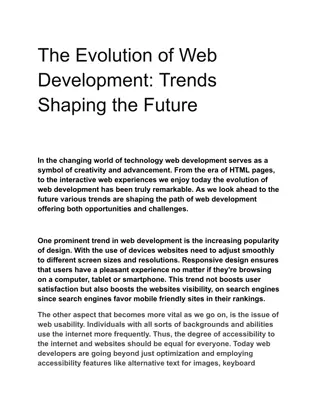
The Evolution of Web Development: Trends and Technologies
In the ever-evolving landscape of technology, web development stands as a dynamic field, continuously adapting to new trends and technologies. From the early days of static HTML pages to the sophisticated web applications of today, the journey of web
Download Presentation

Please find below an Image/Link to download the presentation.
The content on the website is provided AS IS for your information and personal use only. It may not be sold, licensed, or shared on other websites without obtaining consent from the author. If you encounter any issues during the download, it is possible that the publisher has removed the file from their server.
You are allowed to download the files provided on this website for personal or commercial use, subject to the condition that they are used lawfully. All files are the property of their respective owners.
The content on the website is provided AS IS for your information and personal use only. It may not be sold, licensed, or shared on other websites without obtaining consent from the author.
E N D
Presentation Transcript
The Evolution of Web Development: Trends and Technologies In the ever-evolving landscape of technology, web development stands as a dynamic field, continuously adapting to new trends and technologies. From the early days of static HTML pages to the sophisticated web applications of today, the journey of web development has been marked by innovation and progress. This article explores the evolution of web development, highlighting key trends and technologies that have shaped its trajectory. Web development, the art and science of creating websites and web applications, has witnessed a remarkable evolution since its inception. In its nascent stages, web development primarily revolved around the creation of simple static web pages using HTML (Hypertext Markup Language). These static websites, though limited in functionality, paved the way for the digital revolution, marking the dawn of the internet era. As the internet gained traction, the demand for more dynamic and interactive web experiences grew exponentially. This demand led to the emergence of technologies such as CSS (Cascading Style Sheets) and JavaScript, which revolutionized the way websites were designed and developed. CSS enabled developers to enhance the visual appeal of web pages, while JavaScript empowered them to create dynamic content and interactive user interfaces. The advent of Web 2.0 brought about a paradigm shift in web development, emphasizing user- generated content, collaboration, and interactivity. Social media platforms, blogs, and content management systems (CMS) emerged as prominent examples of Web 2.0 applications, reshaping the online landscape and driving innovation in web development. In recent years, the proliferation of mobile devices has had a profound impact on web development. The rise of responsive web design has become a cornerstone of modern web development practices, enabling websites to adapt seamlessly to various screen sizes and devices. This shift towards mobile-first design reflects the changing preferences and behaviors of users, who increasingly rely on smartphones and tablets to access the internet. Another notable trend in web development is the growing popularity of JavaScript frameworks and libraries such as React, Angular, and Vue.js. These frameworks provide developers with powerful tools and abstractions for building complex web applications with ease. By leveraging the capabilities of these frameworks, developers can create interactive user interfaces, manage state efficiently, and optimize performance across different platforms. Web development has also witnessed a shift towards serverless architecture, which eliminates the need for managing server infrastructure and allows developers to focus on writing code. Serverless platforms such as AWS Lambda and Google Cloud Functions enable developers to deploy code in response to events and pay only for the resources consumed, thereby reducing operational overhead and increasing scalability. The rise of artificial intelligence (AI) and machine learning (ML) is another trend reshaping the landscape of web development. AI-powered chatbots, recommendation engines, and personalization algorithms are becoming increasingly prevalent on websites and web applications, enhancing user experiences and driving engagement.
As the field of web development continues to evolve, it is essential for developers to stay abreast of emerging trends and technologies. Continuous learning and skill development are key to remaining competitive in an ever-changing industry landscape. Whether it's mastering new programming languages, exploring cutting-edge frameworks, or embracing innovative development methodologies, staying ahead of the curve is essential for success in web development. In conclusion, the evolution of web development has been characterized by innovation, adaptation, and constant change. From static HTML pages to dynamic web applications powered by AI and machine learning, the journey of web development reflects the transformative power of technology. As we look to the future, the pace of change in web development shows no signs of slowing down. Embracing emerging trends and technologies will be essential for developers looking to create the next generation of innovative web experiences. Web development is not just about building websites; it's about shaping the digital landscape and pushing the boundaries of what's possible online. By embracing new technologies, adopting best practices, and staying curious and adaptable, developers can continue to drive the evolution of web development forward, shaping the future of the internet for generations to come. Author: (David Hawk) David Hawk is an Expert in Digital Marketing having 7+ years of experience in this industry.






















